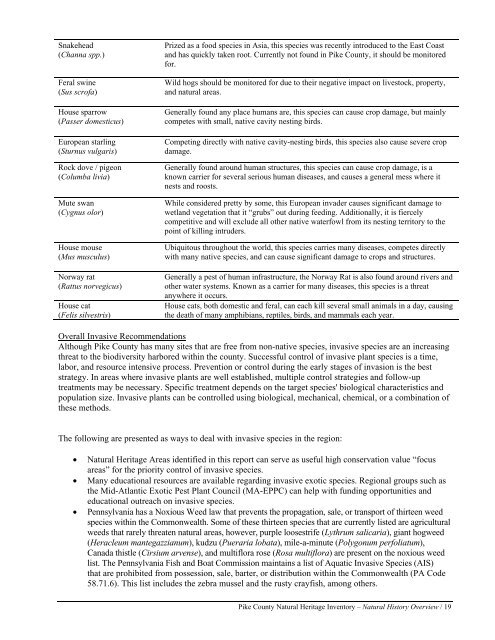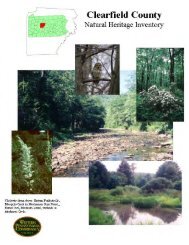Pike CNHI - Pennsylvania Natural Heritage Program
Pike CNHI - Pennsylvania Natural Heritage Program
Pike CNHI - Pennsylvania Natural Heritage Program
Create successful ePaper yourself
Turn your PDF publications into a flip-book with our unique Google optimized e-Paper software.
Snakehead<br />
(Channa spp.)<br />
Feral swine<br />
(Sus scrofa)<br />
House sparrow<br />
(Passer domesticus)<br />
European starling<br />
(Sturnus vulgaris)<br />
Rock dove / pigeon<br />
(Columba livia)<br />
Mute swan<br />
(Cygnus olor)<br />
House mouse<br />
(Mus musculus)<br />
Norway rat<br />
(Rattus norvegicus)<br />
House cat<br />
(Felis silvestris)<br />
Prized as a food species in Asia, this species was recently introduced to the East Coast<br />
and has quickly taken root. Currently not found in <strong>Pike</strong> County, it should be monitored<br />
for.<br />
Wild hogs should be monitored for due to their negative impact on livestock, property,<br />
and natural areas.<br />
Generally found any place humans are, this species can cause crop damage, but mainly<br />
competes with small, native cavity nesting birds.<br />
Competing directly with native cavity-nesting birds, this species also cause severe crop<br />
damage.<br />
Generally found around human structures, this species can cause crop damage, is a<br />
known carrier for several serious human diseases, and causes a general mess where it<br />
nests and roosts.<br />
While considered pretty by some, this European invader causes significant damage to<br />
wetland vegetation that it “grubs” out during feeding. Additionally, it is fiercely<br />
competitive and will exclude all other native waterfowl from its nesting territory to the<br />
point of killing intruders.<br />
Ubiquitous throughout the world, this species carries many diseases, competes directly<br />
with many native species, and can cause significant damage to crops and structures.<br />
Generally a pest of human infrastructure, the Norway Rat is also found around rivers and<br />
other water systems. Known as a carrier for many diseases, this species is a threat<br />
anywhere it occurs.<br />
House cats, both domestic and feral, can each kill several small animals in a day, causing<br />
the death of many amphibians, reptiles, birds, and mammals each year.<br />
Overall Invasive Recommendations<br />
Although <strong>Pike</strong> County has many sites that are free from non-native species, invasive species are an increasing<br />
threat to the biodiversity harbored within the county. Successful control of invasive plant species is a time,<br />
labor, and resource intensive process. Prevention or control during the early stages of invasion is the best<br />
strategy. In areas where invasive plants are well established, multiple control strategies and follow-up<br />
treatments may be necessary. Specific treatment depends on the target species' biological characteristics and<br />
population size. Invasive plants can be controlled using biological, mechanical, chemical, or a combination of<br />
these methods.<br />
The following are presented as ways to deal with invasive species in the region:<br />
<strong>Natural</strong> <strong>Heritage</strong> Areas identified in this report can serve as useful high conservation value “focus<br />
areas” for the priority control of invasive species.<br />
Many educational resources are available regarding invasive exotic species. Regional groups such as<br />
the Mid-Atlantic Exotic Pest Plant Council (MA-EPPC) can help with funding opportunities and<br />
educational outreach on invasive species.<br />
<strong>Pennsylvania</strong> has a Noxious Weed law that prevents the propagation, sale, or transport of thirteen weed<br />
species within the Commonwealth. Some of these thirteen species that are currently listed are agricultural<br />
weeds that rarely threaten natural areas, however, purple loosestrife (Lythrum salicaria), giant hogweed<br />
(Heracleum mantegazzianum), kudzu (Pueraria lobata), mile-a-minute (Polygonum perfoliatum),<br />
Canada thistle (Cirsium arvense), and multiflora rose (Rosa multiflora) are present on the noxious weed<br />
list. The <strong>Pennsylvania</strong> Fish and Boat Commission maintains a list of Aquatic Invasive Species (AIS)<br />
that are prohibited from possession, sale, barter, or distribution within the Commonwealth (PA Code<br />
58.71.6). This list includes the zebra mussel and the rusty crayfish, among others.<br />
<strong>Pike</strong> County <strong>Natural</strong> <strong>Heritage</strong> Inventory – <strong>Natural</strong> History Overview / 19










